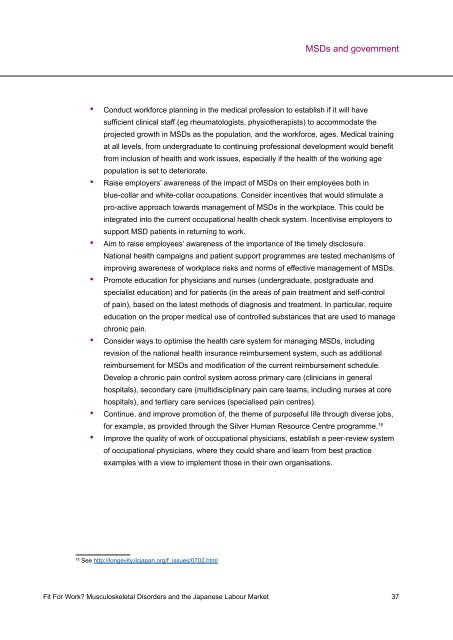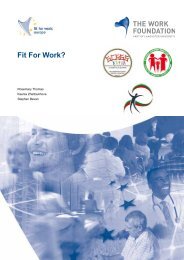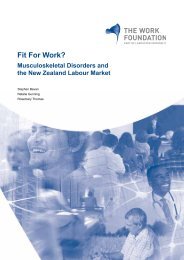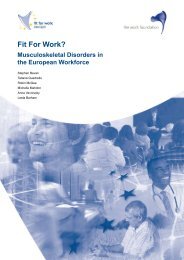English version - Fit for Work Europe
English version - Fit for Work Europe
English version - Fit for Work Europe
You also want an ePaper? Increase the reach of your titles
YUMPU automatically turns print PDFs into web optimized ePapers that Google loves.
• Conduct work<strong>for</strong>ce planning in the medical profession to establish if it will have<br />
sufficient clinical staff (eg rheumatologists, physiotherapists) to accommodate the<br />
projected growth in MSDs as the population, and the work<strong>for</strong>ce, ages. Medical training<br />
at all levels, from undergraduate to continuing professional development would benefit<br />
from inclusion of health and work issues, especially if the health of the working age<br />
population is set to deteriorate.<br />
• Raise employers’ awareness of the impact of MSDs on their employees both in<br />
blue-collar and white-collar occupations. Consider incentives that would stimulate a<br />
pro-active approach towards management of MSDs in the workplace. This could be<br />
integrated into the current occupational health check system. Incentivise employers to<br />
support MSD patients in returning to work.<br />
• Aim to raise employees’ awareness of the importance of the timely disclosure.<br />
National health campaigns and patient support programmes are tested mechanisms of<br />
improving awareness of workplace risks and norms of effective management of MSDs.<br />
• Promote education <strong>for</strong> physicians and nurses (undergraduate, postgraduate and<br />
specialist education) and <strong>for</strong> patients (in the areas of pain treatment and self-control<br />
of pain), based on the latest methods of diagnosis and treatment. In particular, require<br />
education on the proper medical use of controlled substances that are used to manage<br />
chronic pain.<br />
• Consider ways to optimise the health care system <strong>for</strong> managing MSDs, including<br />
revision of the national health insurance reimbursement system, such as additional<br />
reimbursement <strong>for</strong> MSDs and modification of the current reimbursement schedule.<br />
Develop a chronic pain control system across primary care (clinicians in general<br />
hospitals), secondary care (multidisciplinary pain care teams, including nurses at core<br />
hospitals), and tertiary care services (specialised pain centres).<br />
• Continue, and improve promotion of, the theme of purposeful life through diverse jobs,<br />
<strong>for</strong> example, as provided through the Silver Human Resource Centre programme. 18<br />
• Improve the quality of work of occupational physicians, establish a peer-review system<br />
of occupational physicians, where they could share and learn from best practice<br />
examples with a view to implement those in their own organisations.<br />
18 See http://longevity.ilcjapan.org/f_issues/0702.html<br />
MSDs and government<br />
<strong>Fit</strong> For <strong>Work</strong>? Musculoskeletal Disorders and the Japanese Labour Market 37







